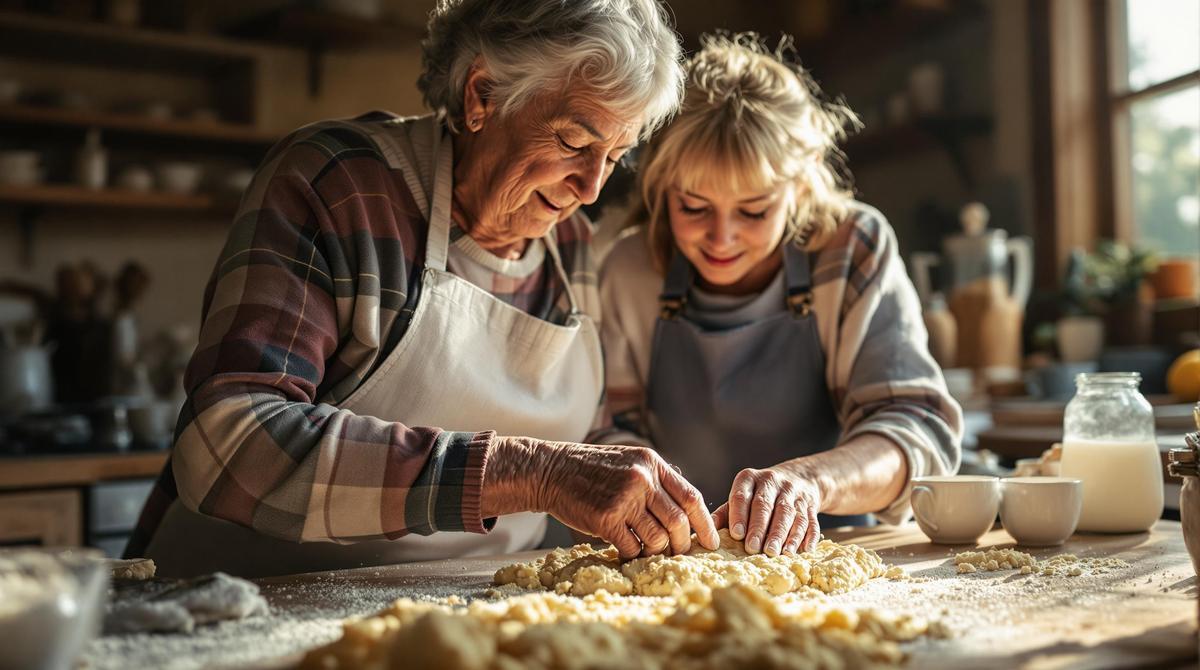There’s something almost magical about a properly made scone. As a young cook in Scotland, I watched my grandmother’s hands—weathered but nimble—barely touch the dough as she worked. “The secret,” she’d whisper conspiratorially, “is treating your scones like they’re made of gossamer.” That wisdom has stayed with me through two decades in professional kitchens. Today, I’m sharing my grandmother’s treasured recipe with one crucial modification that transformed her already delicious scones into cloud-like perfection.
The Secret to Ethereal Grandmother-Style Scones 🍞
Traditional scones originated in Scotland in the 1500s as simple oat cakes cooked on griddles. Over centuries, they evolved into the baked treats we know today—beloved centerpieces of afternoon tea services across the UK. What makes a truly exceptional scone isn’t fancy ingredients or complicated techniques, but rather understanding a few fundamental principles that grandmothers have passed down through generations.
The most surprising revelation? Even when using self-raising flour, adding additional baking powder creates an extra chemical reaction that produces remarkably light, fluffy scones. This grandmother wisdom, paired with keeping ingredients properly chilled, makes all the difference between dense hockey pucks and tender, cloud-like treats.
Essential Ingredients for Perfect Scones 🧾
• 450g (3½ cups) self-raising flour, plus extra for dusting
• 1½ teaspoons baking powder (yes, even with self-raising flour!)
• 100g (7 tablespoons) unsalted butter, very cold and cubed
• 50g (¼ cup) caster sugar (optional for sweetness)
• 375ml (1½ cups) cold full-fat milk
• 1 egg, beaten (for egg wash)
• 50g (⅓ cup) sultanas or currants (optional)
Chef’s Note: The temperature of your ingredients truly matters. I keep my butter in the freezer for 15 minutes before cubing it, and I measure the milk straight from the refrigerator. Cold ingredients create steam pockets during baking, resulting in that coveted light texture.
The Grandmother Method 📝
- Preheat your oven to 220°C (425°F) and line a baking tray with parchment paper.
- Sift the self-raising flour and baking powder into a large, chilled bowl. This extra sifting incorporates air for lighter scones.
- Add the cold cubed butter to the flour mixture. Using your fingertips (the coolest part of your hands), quickly rub the butter into the flour until it resembles fine breadcrumbs.
- If using sugar and dried fruit, gently fold them through now.
- Make a well in the center and pour in about ¾ of the milk. Using a butter knife or fork (not your warm hands), gently bring the mixture together with a cutting motion.
- Add just enough remaining milk to form a slightly sticky dough. The mixture should be soft but not wet or overly sticky.
- Turn onto a lightly floured surface and pat (don’t roll) to about 2cm (¾ inch) thickness.
- Cut rounds using a 5cm (2-inch) cutter, pressing straight down without twisting (twisting seals the edges and prevents proper rising).
- Place scones on the prepared tray about 2cm apart. Brush tops with beaten egg for golden color.
- Bake for 12-15 minutes until well-risen and golden.
Classical Technique Meets Home Kitchen 🤫
In professional kitchens, we obsess over “the touch”—knowing exactly how much to work a dough. With scones, less is decidedly more. I tell home cooks to imagine they’re handling a sleeping baby: gentle, minimal, and respectful. Overworked dough develops gluten, resulting in tough scones rather than tender ones.
Another professional trick is to freeze your butter, then grate it into the flour instead of cubing it. This creates more uniform distribution without warming the butter with your hands.
If you don’t have self-raising flour, substitute with 450g plain flour plus 3 teaspoons baking powder. Missing sultanas? Try dried cranberries, blueberries, or even small dices of apple for delightful variations.
Serving Your Masterpiece 🍽️
Traditionally, scones are served warm with clotted cream and strawberry jam. Whether you follow the Devonshire method (cream first, then jam) or the Cornish approach (jam first, then cream) remains a personal choice—though one that can spark lively debate at afternoon tea!
For a surprisingly delightful twist, try savory scones paired with salted butter and chutney, or even caramelized tomato paste. My Italian grandmother-in-law would sometimes serve a version alongside a lemon tiramisu for an Anglo-Italian fusion tea service.
For the perfect accompaniment, brew a pot of Earl Grey or English Breakfast tea—the tannic notes balance the rich, buttery scones beautifully. Just as my grandmother taught me decades ago, the beauty of scones lies in their humble elegance—they don’t require elaborate presentation, just proper technique and a few special touches like grandmother’s other kitchen secrets.
Remember, the scones of our grandmothers tell stories of heritage and love. When you bite into that tender, slightly crumbly texture—still warm from the oven—you’re not just enjoying a pastry; you’re participating in a timeless tradition. Now go forth and bake with confidence, knowing you hold the secret to truly exceptional scones.
